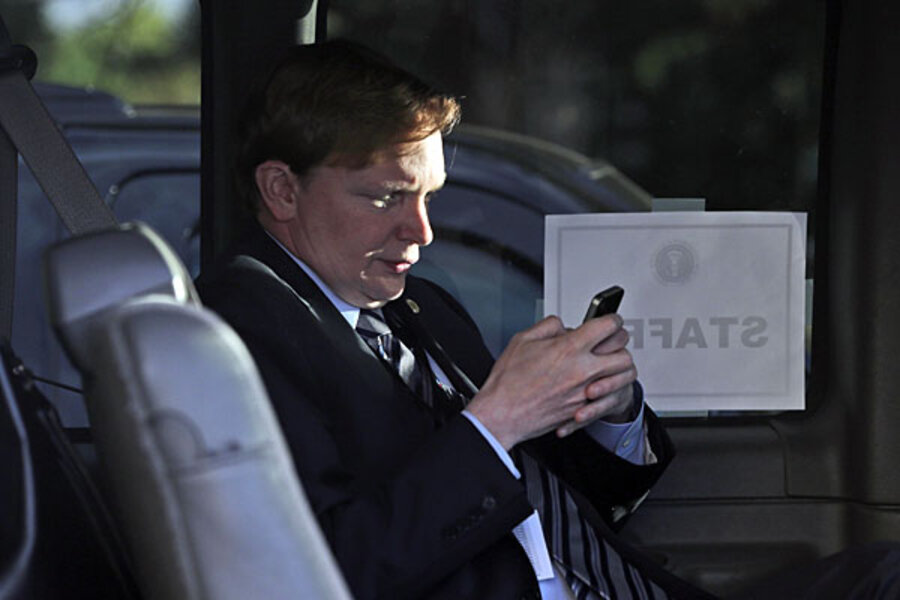Electing a president: Five insights from Obama campaign manager Jim Messina
Loading...
| Washington
Depending on one’s politics, Jim Messina is either a conquering hero or a figure of intense envy.
Either way, the manager of President Obama’s successful reelection campaign was the man of the hour in Washington Tuesday, when he sat down for a chat with Politico’s Mike Allen before a standing-room-only crowd.
Mr. Messina’s story begins with the president asking him to build a grassroots-oriented campaign. By doing that, Messina said, “that’s how we got to turnout numbers that a whole bunch of people spent 18 months telling me we couldn’t get to.”
Specifically, Republicans and other political observers insisted the Obama campaign would not be able to turn out minorities, women, and young voters in numbers that matched the 2008 campaign.
Amid high unemployment and sluggish economic growth, the enthusiasm just wasn’t there, Team Obama kept hearing. Many public polls seemed to bear that out. But the result proved otherwise.
“We built the biggest grassroots campaign in modern American political history,” Messina said.
So how did that work, exactly? Here are five takeaways from Messina’s remarks:
1. Voters have to be wooed. In other words, you can’t just build it (a campaign) and assume they (voters) will come. Messina says it starts with the candidate: “We won this election because of Barack Obama.”
The next step is to run a “sustained operation,” with lots of voter contact. In the 2010 midterms, Democrats thought they could put Obama’s picture on a piece of literature and his supporters would “magically” turn out for them, Messina said.
“It doesn’t work like that,” he said. There needs to be “an ongoing conversation about why they should support the president, about why they should get out and vote.”
In September 2011, the Obama campaign launched Operation Vote, which focused on eight target groups: women, blacks, seniors, Hispanics, Asian-Americans, Jews, gays, and young voters. With African-Americans, for example, there was particular outreach at beauty parlors, barber shops, black-owned businesses, and historically black colleges.
2. Door-knocking will only grow in importance. A flood of money from outside groups – a result of the 2010 Supreme Court ruling Citizens United – created a “huge cacaphony of television” in the final months of the campaign, making it harder for any one message to stand out.
Targeted door-knocking – only going to doors where you know the voter is persuadable or perhaps just needs a nudge to hand in their absentee ballot – became a way to rise above the din.
“Door-knocking is going to be even more important in the future,” says Messina.
“A simple door knock from a trusted neighbor really mattered more than anything else – to say, ‘Hey, let me tell you why I’m supporting Barack Obama, I live down the street, let me tell you about an issue you care about,’ ” Messina says. “And that, we found, became incredibly important to how people were going to vote.”
3. Technology is still king. Masses of data about each voter’s political tendencies – gathered through public sources and through campaign contact – allowed Obama for America (OFA) to target voters more precisely than ever before.
One technique the campaign developed was “targeted-sharing,” in which users could send campaign materials to their friends via Facebook.
“You’re going to be wherever the voter is,” Messina said. That meant Facebook, Twitter, Tumblr, Google, and not necessarily BarackObama.com.
OFA’s analytics department of more than 60 full-time people kept the campaign informed on how it was doing on a daily basis.
“We could build support scores for every single voter in battleground states, 1 to 100, on whether they would support us,” Messina said.
“We went in every day" after early voting had started "and sampled people to see whether or not our model was right,” he added. “Our modeling ended up predicting our final vote in Florida within 0.2 percent.”
At the start of the 2012 cycle, one of the smartest pieces of advice Messina says he got came from Google CEO Eric Schmidt, who told him “you don’t want political people, you want smart people.” The campaign would describe what it wanted, and the tech people would build it.
4. In some ways, the next Democratic nominee will have to start over. Today’s state-of-the-art campaign will be old hat by the beginning of 2015 – the start of the 2016 cycle.
Early in the 2012 cycle (that is, in early 2011) Messina consulted with Steven Spielberg. The filmmaker’s advice: “Blow up the campaign.” In other words, whatever worked in 2008 was by then hopelessly obsolete.
Messina says the same will hold true for the manager of the 2016 Democratic presidential campaign. “Whoever has my job next should blow it up and build their own campaign, because everything will change again in four years,” he said.
5. The future of public polling. Messina had nothing but disdain for the publicly available polls during the 2012 campaign cycle, many of which were off-base. “I think a bunch of polling is broken in the country,” he said.
Part of the issue, he said, is the rise of cell-phone-only households. When those aren’t sampled, or are under-sampled, then pollsters are failing to reach enough young and minority voters. And on all phones, pollsters are now getting response rates under 10 percent. That makes reaching a big enough sample for a credible poll increasingly expensive.
Another mistake pollsters made was to assume an electorate that looked more like the one that voted in 2004 and less like 2008, which had larger-than-usual minority and youth turnout. In the end, 2012 looked like 2008.






